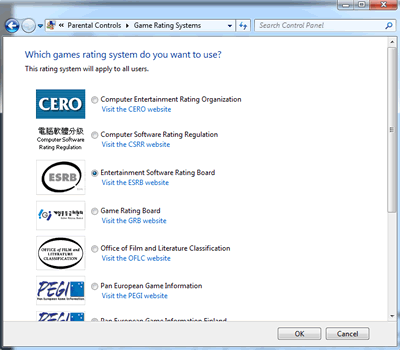Configuring Parental Controls
To set up Parental Controls, you first need to configure one or more user accounts as standard user accounts; these are the accounts that your children will use.
Tip Parental Controls cannot be applied to an administrator-class account. They can be applied only to standard users. In addition, there's another limitation. While it's technically possible to configure Parental Controls on a system in which one or more administrators do not have passwords, doing so would be folly. Parental Controls rely on the controlled accounts (your kids' accounts) not having access to administrator accounts. If one or more administratorclass accounts do not have passwords, your kids will be able to bypass any controls you set up. Thus, be sure that any administrator-class accounts on the PC have passwords.
Then, from an administrator account, you can configure Parental Controls. To do so, just type parental in Start Menu Search to locate and access the Parental Controls application. Then select the user to which you'd like to add Parental Controls. You will see the User Controls dialog.
Tip You will most likely see a message in the Parental Controls control panel stating that web filtering and activity reporting are not available on this computer. In Windows Vista, these features were part of the built-in Parental Controls functionality. But in Windows 7, these features are now part of Windows Live Family Safety, which you must install and configure separately. We look at Family Safety-and these features-later in this tutorial.
TipYou can configure Parental Controls on only one account at a time. If you have three children to whom you'd like to apply identical Parental Controls, unfortunately you will have to repeat these steps for each of your children's accounts.
By default, Parental Controls are not enabled for any standard user accounts. When you do enable Parental Controls by checking the option titled On, enforce current settings, you can configure the features discussed in the following sections.
Time Limits
This is one of our favorite Parental Controls because it's so obvious and graphical. The Time Restrictions Parental Controls provides a graphical grid that enables you to configure exactly when your kids can use the computer. By default, Windows 7 users can use the PC on any day at any time, but by dragging your mouse around the grid you can prevent your children from using the computer at specific hours, such as late at night or during school hours.
Games
The Game Restrictions Parental Controls specifies whether your children can play games on the PC and, if so, which games they can access. By default, standard account holders can play all games. Of course, you can fine-tune that setting using the screen shown in Figure below, which appears when you click Set game ratings.

Here you can set acceptable game ratings using the rating system enabled on your PC. The most common and default system (regardless of where you are in the world) is the Entertainment Software Ratings Board's (ESRB). Additionally, you can block games based on content, using a surprising range of content types, including unrated online games, alcohol and tobacco reference, alcohol reference, animated blood, blood, blood and gore, cartoon violence, comic mischief, crude humor, drug and alcohol reference, drug and tobacco reference, drug reference, edutainment, fantasy violence, and about 200 others. It's a long list.
Finally, you can also block or allow specific games, which is surprisingly helpful because many Windows games do not digitally identify their rating. The nice thing about this UI, is that Parental Controls sees which games are already installed on the system and enables you to supply a Caesar-style yea or nay.
Where Did the Activity Reporting and Web Filtering Features Go?
Users of Windows Vista's Parental Controls feature will probably notice two features missing after upgrading Windows 7. To streamline Windows 7, Microsoft removed the Activity Reporting and Web Filtering features, replacing it with a behind-the-scenes framework that allows trusted third-party providers to extend Windows' built-in Parental Control functionality.
These features aren't really gone, though. Microsoft simply moved these features into their free Windows Live Family Safety product, which comes bundled with code that hooks directly into Windows 7. We will go over Windows Live Family Safety in a moment.
One of the most unique features of Windows 7's Parental Controls is that they don't necessarily have to be limited to children. Indeed, many security-conscious users will find that it's worth setting up a standard user account for themselves, applying various Parental Controls to it, and then using that account for their normal PC operations. Why would you want to do such a thing? Well, for starters, you might want to protect yourself from some of the nastier things that happen online. It's something to think about.
In this tutorial:
- Users, Accounts, and UAC
- Understanding User Accounts
- Creating the Initial User Account
- Understanding Account Types
- User Account Control
- How UAC Works
- How UAC Has Changed in Windows 7
- Changing How UAC Works (The Hard Way)
- Parental Controls
- Configuring Parental Controls
- Running as Standard User with Parental Controls
- Extending Parental Controls with Windows Live Family Safety
